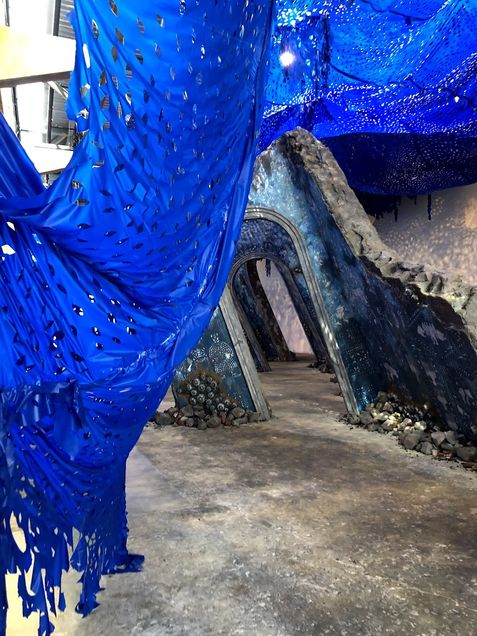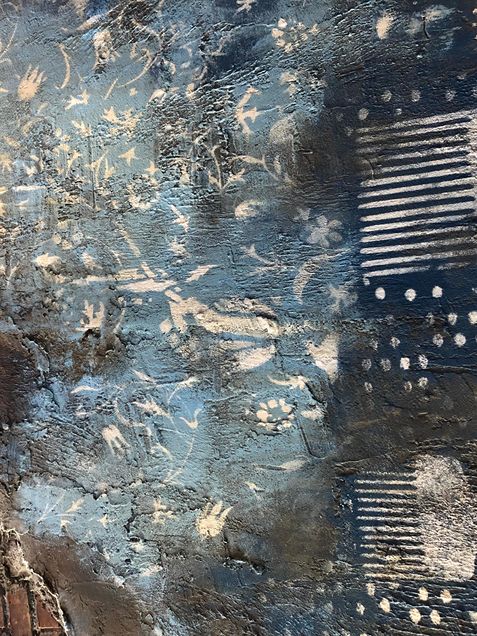Firelei Báez and Stephen Hamilton: Indigo
ICA Watershed, Institute of Contemporary Art / Boston
July 3—September 6, 2021
by Colleen Foran

Since 2018, the Institute of Contemporary Art / Boston (ICA) has annually commissioned a site-specific installation for the Watershed, its outpost in East Boston.1 This year’s exhibition highlighted the work of Dominican-American artist Firelei Báez (b. 1981). Báez’s family had roots in both the Dominican Republic and Haiti, and her childhood was inflected by growing up near the Haitian border. She was acutely aware of shared histories and ethnicity-based tensions between the two nations—and of the power of visual representation to either reinforce or break down such barriers.2 This early understanding of cultural identity as in flux inspired the work that made Báez an art-world star: lush, detailed depictions of bodies in transformation and hybrid folkloric creatures, often painted or drawn over reproduced historical maps.
The exhibition centerpiece, however, was Báez’s vision of the ruins of Haitian palace Sans-Souci, titled To breathe full and free: a declaration, a re-visioning, a correction (19º36’16.9”N 72º13’07.0’’W, 42º21’48.762’’N 71º1’59.628’’W) (2021) (fig. 1).3 The architectural fragment included five arches, angled precariously to suggest that it was slipping into the seabed as a blue tarp undulated overhead to mimic waves. Sans-Souci was a complex space to resurrect; the luxurious nineteenth-century palace was built by Henri Christophe (1767–1820), a leader of the Haitian Revolution who would controversially rule as king of northern Haiti from 1811 until he died by suicide in 1820. His political rivals would go on to unite the fractious nascent nation, while Christophe’s royal residence was left to decay after a destructive 1842 earthquake.4 The Haitian Revolution is the most successful rebellion of enslaved people in history. From 1789 to 1804, African-descended residents of the colony Saint-Domingue liberated themselves from French rule and built the first Black republic in the world.5 Yet the legacy of colonialism and white supremacy has continued to hamper Haiti. As natural disasters and political violence rocked the Caribbean nation throughout the summer of 2021, these resonances weighed heavy for the exhibition visitor.6
The recreation of Sans-Souci struggled to bear this density of reference. Its scale, while enormous, still failed to fill the massive industrial warehouse, making the installation feel less immersive than overwhelmed. This issue was shared by the audio component, which, according to didactics, featured recordings of migration stories from residents of East Boston.7 The testimonies were intended to emphasize the exhibition’s site-specificity and reinforce the goals of the artist and curator to embed it within a specific neighborhood.8 However, they were played at such a low volume that the soundscape was reduced to an occasional burble. An opportunity to root the exhibition in its surrounding community—long the home of recent immigrants, including its current majority-Hispanic population—was lost in the cavernous space.
Figure 2. Firelei Báez (b. Dominican Republic, 1981). Detail, To breathe full and free: a declaration, a re-visioning, a correction (19º36’16.9”N 72º13’07.0’’W, 42º21’48.762’’N 71º1’59.628’’W) (2021). Installation view, Firelei Báez. ICA Watershed, East Boston, 2021. Photo by the author, 2021; Figure 3. Firelei Báez (b. Dominican Republic, 1981). Detail, To breathe full and free: a declaration, a re-visioning, a correction (19º36’16.9”N 72º13’07.0’’W, 42º21’48.762’’N 71º1’59.628’’W) (2021). Installation view, Firelei Báez. ICA Watershed, East Boston, 2021. Photo by the author, 2021; Figure 4. Firelei Báez (b. Dominican Republic, 1981). Detail, To breathe full and free: a declaration, a re-visioning, a correction (19º36’16.9”N 72º13’07.0’’W, 42º21’48.762’’N 71º1’59.628’’W) (2021). Installation view, Firelei Báez. ICA Watershed, East Boston, 2021. Photo by the author, 2021; Figure 5. Firelei Báez (b. Dominican Republic, 1981). Detail, To breathe full and free: a declaration, a re-visioning, a correction (19º36’16.9”N 72º13’07.0’’W, 42º21’48.762’’N 71º1’59.628’’W) (2021). Installation view, Firelei Báez. ICA Watershed, East Boston, 2021. Photo by the author, 2021; Figure 6. Firelei Báez (b. Dominican Republic, 1981). Detail, To breathe full and free: a declaration, a re-visioning, a correction (19º36’16.9”N 72º13’07.0’’W, 42º21’48.762’’N 71º1’59.628’’W) (2021). Installation view, Firelei Báez. ICA Watershed, East Boston, 2021. Photo by the author, 2021.
This was an installation intended to be seen (or, perhaps, photographed) from a distance. The sensation of being plunged underwater was potent—and important—in a city threatened by rising sea levels.9 Closer inspection dispelled the illusion. The sinking arches were anchored by blocks (textured to look like stone but without convincing heft) and what was clearly shredded rubber (fig. 2). The tarp’s distressed appearance was disproved by its regular, repeated holes, which only partly screened the harsh industrial lighting that punctured the watery impression (fig. 3, see also fig. 1). These aspects destabilized some of the less-convincing connections being drawn between Sans-Souci and the Watershed—the real palace, after all, was not submerged by a flood, but damaged by an earthquake. They accentuated that these ruins occurred artificially, outside of historical processes, and lent the installation an appealingly aesthetic sense of fantasy.
Age and decay were further connoted through fabricated barnacles. There was evident care and attention here, with sand carefully applied to blur the edges of each cluster (fig. 4). But the barnacles did not withstand scrutiny, especially when compared with the real-life creatures abundantly visible on nearby harbor structures. Viewers were encouraged to look closely at these additions because of what they partially obscured: repeating patterns stenciled across the monument’s blue-painted surface that alluded to African diasporic identities and lineages of Black resistance (figs. 5, 6). The color and symbols referenced indigo textile techniques that enslaved Africans brought with them from West Africa to the Americas and that became a staple good of the transatlantic slave trade—of which Boston’s harbor was a crucial node.10


The sense that Baez’s version of Sans-Souci was a theater set, rather than a real place, was thrown into sharp relief by the paired exhibition Indigo featuring Boston-based artist Stephen Hamilton (b. 1982). The small exhibition punched above its weight and grounded Báez’s smart exposure of cross-continental histories. Without it, the allusions to indigo as a connection point for the African diaspora would have been far more abstracted, only semi-visible on the intentionally deteriorated palace surface (see fig. 6). The show featured five textiles by Hamilton in the educational area at the rear of the building. These works displayed the techniques he had studied in southwestern Nigeria, including the making of natural dyes and loom-weaving (figs. 7, 8). Accompanying wall labels included photographs taken in Nigeria that illustrated these methods for the visitor. The showstopper was Owners of the Earth (2020), a mixed-media wall hanging that depicted three reposed women surrounded by emblems of classical Yoruba art against the backdrop of resist-dyed indigo fabric (adire) (fig. 7). As a Black American, Hamilton understands his process-oriented practice and research into historical African art as a restorative recovery of stolen knowledge.11
It was tactility that distinguished the artworks; Hamilton’s pieces rewarded long, careful looking, with evidence of the hand-at-work in every layered detail. Showing the exhibitions in the same venue was an inspired choice to drive home the material legacies of the transatlantic slave trade. The worldwide dispersal of indigo fabric and its production trailed that of millions of kidnapped and enslaved Africans to the Americas and the Caribbean. That exchange underwrote Boston’s growing wealth as a colonial port, just as it foreshadowed Haiti’s eventual liberation and struggles to succeed in the face of colonial underdevelopment.
From the shores of Boston, Haiti might seem distant, as do the cultures and traditions of West Africa. Yet these locations are intimately linked, historically and presently, through the forces of migration, global trade, and a changing climate. Báez and Hamilton are artists both extremely adept at revealing these connections. This presentation of Báez’s work, however, emphasized aesthetic over substance, the imaginary over the tangible, surface over depth. Its details called to mind the constructed nature of the space more than the passage of time. The set dressing contrasted with Hamilton’s textiles, which he created as a labor of time-intensive love informed by deep research into West African traditions of making. Seen together, these two bodies of work marked the distance between fantasy and reality—in all its painful, messy, intertwined layers.
____________________
Colleen Foran
Colleen Foran is a PhD student studying African art at Boston University. Her research focuses on contemporary West African art, particularly on public and participatory art in Ghana’s capital of Accra. Prior to coming to BU, Colleen worked at the Smithsonian National Museum of African Art in the curatorial, editorial, and advancement departments. She completed her MA in May 2020, as well as a Graduate Certificate in African Studies from BU’s African Studies Center
____________________
Footnotes
1. With the exception of the summer of 2020, when the initiative was suspended due to COVID-19 and the Watershed pivoted to become a food distribution center for hard-hit East Boston communities.
2. Siddhartha Mitter, “In Boston, Art That Rises From the Deep,” New York Times, July 2, 2021, https://www.nytimes.com/2021/07/02/arts/design/28firelei-baez-ica-boston.html.
3. The parenthetical of this lengthy title references the geographic coordinates for Sans-Souci in Haiti, followed by those of the Watershed in Boston, thus explicitly indicating distant physical locations were entangled within the space of the installation.
4. Wall text, Firelei Báez, ICA Watershed, East Boston.
5. Elizabeth Maddock Dillon and Michael J. Drexler, “Introduction: Haiti and the Early United States, Entwined,” in The Haitian Revolution and the Early United States: Histories, Textualities, Geographies, edited by Elizabeth Maddock Dillon and Michael Drexler (Philadelphia, PA: University of Pennsylvania Press, 2016), 1–2.
6. The first half of 2021 saw continuous protests in Haiti’s capital against President Jovenel Moïse after he controversially retained power beyond expected term limits. Then, on July 7, 2021, Moïse was assassinated in a shocking attack on his Port-au-Prince home. The political situation in Haiti remains uncertain, as various groups vie for political and on-the-ground power. This instability was compounded when a 7.2 magnitude earthquake struck the island nation on August 14, 2021, causing widespread damage and killing thousands. Shortly after, recovery efforts were hampered by a severe tropical storm. Early autumn brought news of thousands of Haitian migrants gathering on the southern United States border seeking asylum—a further reminder of the interconnectedness of Haitian and American histories and futures.
7. Wall text, Firelei Báez, ICA Watershed, East Boston.
8. Báez previously created a smaller fragment of Sans-Souci for an exhibition on New York City’s High Line, on view from May 2019 to May 2020. This version shared the Watershed example’s patterning and appearance but was titled solely with the palace’s geographic coordinates: 19.604692°N 72.218596°W (2019); Mitter, “In Boston, Art That Rises From the Deep.”
9. Not far from the ICA’s Seaport location, the corner of an almost entirely submerged luxury condo building surfaced from the waters of Fort Point Channel—a reminder of what the area could look like in just a few years. This portent, a work of art titled Polarity (2021) by Boston artist Zy Baer (b. 1993), was on view in the harbor throughout the summer, like the Watershed’s installation. It was not, however, sponsored by the ICA, but by the local group Fort Point Arts Community.
10. Wall text, Firelei Báez, ICA Watershed, East Boston.
11. Wall text, Stephen Hamilton: Indigo, ICA Watershed, East Boston.




